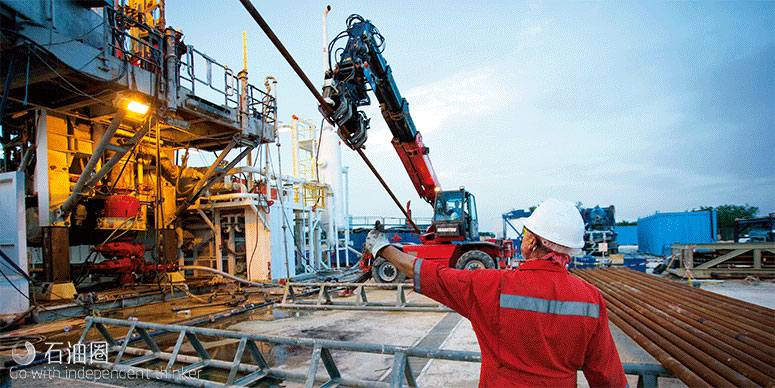
在今年的路易斯安那州海湾石油博览会上,又有众多的新型油气勘探&开采技术和设备亮相,最终,经过评选,有五项技术获得了“促进油气勘探&开采发展重大技术”奖项,本文将对这五种设备进行简单介绍。
来自 | World oil
编译 | 张德凯
2017年10月25日,在Lafayette 进行的LAGCOE在技术讨论阶段展览出了获奖工具和设备。
LAGCOE共授予五家公司“促进油气勘探&开采发展重大技术”称号,获奖技术分别为Expro公司的30000psi级别射孔&钻杆测试工具;Frank公司的复合钻杆/套管卡盘&升降系统;HydraLIFT公司的抽油机专用抽油杆升降设备;Louisiana Cat 公司的产品性能连接面板;Ulterra公司的新型PDC钻头切削结构—CounterForce。
这些获奖技术是在众多参与技术中精挑细选而出的,很可能会对油气勘探&开采造成长远的影响。评审小组负责获奖技术的审核,评价标准主要为五方面:新颖性、创新性、是否获得现场应用验证、是否获得广泛关注及技术影响力,参选技术问世时间不超过2年(以首次投入应用后投入市场计),所有的获奖技术都有各自的专利技术。
Expro公司的30000psi级别射孔&钻杆测试工具专为墨西哥湾深水钻井作业设计,尤其是超高压钻井作业。超高压系列TCP射孔枪压力载荷可达30000psi,是新型测试工具的主要部分,于10月24日在LAGCOE宣布正式投入商业应用。新型射孔枪采用超大孔径填药技术,射孔产生的孔道流动性能为业内一流,支持压裂-砾石充填作业的进行。Expro公司DST/TCP技术商业部门负责人Kerry Daly说:“墨西哥湾地区的油井深度逐渐增加,井下压力也明显升高,目前作业区域的水深已达到10000ft,井筒垂深达到了30000ft,所以,套管的完整性性能必须也随之提升,我们的射孔枪系统完整性完全能够满足此类苛刻条件下的作业”
Frank公司的复合钻杆/套管卡盘&升降系统在2016年5月首次投入商业应用,能够解决一系列复杂管串连接问题,包括端部加厚钻杆/套管、冲管和油管的连接。新工具的适用性极强,只需一套工具组即可完成上述不同规格管串的连接,无需中途更换或调整设备。该公司高级技术副总裁Jeremy Angelle表示:“使用该技术后,作业人员无需靠近井眼完成工具的更换,作业安全性得到提升。无论作业过程中使用哪种管串,无论其尺寸如何变化,都无需更换工具,也无需进行复杂的调整,效率大大提高。”
HydraLIFT公司的抽油机专用抽油杆升降设备是一个液压起重机,可以将抽油杆提拉出井筒,以方便进行井筒排布和井筒间隔离。在该系统的协助下,抽油机垫块可直接在地面进行安装,通过液压起重机就可安全、迅速的将抽油杆拉出井筒。该工具的设计初衷就是提高井筒排布的安全性和效率,同时降低成本。HydraLIFT公司的作业经理Brett Sudistine说:“相比于传统方案,该系统更加安全,成本也更低,是真正意义上的新技术。”
Louisiana Cat公司的产品性能检测面板(PHCP)能够通过互联网记录柴油发动机、蒸汽机数字信息,并将其实时传送至办公室,供设备专家使用。该设备的问世后,作业人员再也不用在现场检测发动机,可以更加专注于其他任务。此外,开发商还可以选择让专业团队监测发动机数据,及时发现可能会出现的故障,在灾难性事故发生前就将其解决。Louisiana Cat公司的产品经理Byron Oliva说:“在当前的作业环境中,大型油气公司正面临着减少作业人员数量、降低成本的压力,而PHCP能够帮助减少作业人员数量、降低成本,同时还能降低作业风险。”
Ulterra公司的新型PDC钻头切削齿结构CounterForce专为机具挑战性的坚硬、粗糙岩层设计,目前该类地层主要出现在墨西哥湾地区。CounterForce采用交替侧耙设计,为该公司专利技术,降低了PDC钻头钻进过程中的震动,与常规PDC钻头相比,CounterForce的耐用性更强。同时,得益于耐用性的提高,CounterForce钻头在保持高ROP的前提下,还提高了钻头的持续使用时间。该公司负责人表示:“我们在几年前就研发得到了该技术,但其在海上钻井作业中应用表现更好,因为海上作业中过早更换钻头的成本实在是太高了,所以,如果你看中钻头的使用寿命,CounterForce钻头的潜力巨大。”
您也有让人挠头的难题需要解决,或是优质技术想要找应用市场吗?如果有的话,欢迎联系小编微信或邮箱,也许能找到一剂良药。
二丫:131-3255-0596;zhanglingyu@raiborn.com
大安:131-3203-1392;lishian@raiborn.com
For English, Please click here (展开/收缩)
New Technology Showcase winners from the 2017 Louisiana Gulf Coast Oil Exposition (LAGCOE) in Lafayette, La., presented their award-winning tools and equipment during a technical session at the conference on Oct. 25.
The awards recognize five companies with “revolutionary technologies that advance the process of discovering and producing oil and natural gas,” according to LAGCOE. The award winners are Expro’s 30,000-psi perforating and drillstem test tool package; Frank’s International’s Combination Drillpipe/Casing Spider & Elevator; HydraLIFT’s rod-raising and lowering device for oil-well beam pumping units; Louisiana Cat’s Product Health Connect Panel; and Ulterra Drilling Technologies’ PDC drill bit cutting structure: CounterForce. These technologies were picked from a large grouping of submissions, due to their capacity to have “an ongoing impact” on the E&P business. They were reviewed from a panel of judges and evaluated on five categories, which are: new, innovative, proven, broad interest and significant impact. Each technology was a maximum of two years old, from the first application or product launch, and all winners introduced new patents.
Expro’s 30,000-psi perforating and drillstem test tool package was designed for deepwater Gulf of Mexico drilling operations and, specifically, for use in extremely high-pressure applications. One part of the package, the Extreme Pressure Series 30,000-psi TCP gun system, was commercially launched on Oct. 24 at LAGCOE. It utilizes “super-big hole charge technology, providing best-in-class area open-to-flow” to support frac-and-gravel-pack operations. As the wells get deeper and deeper in the Gulf of Mexico, “the pressure has increased, the water depths have increased up to 10,000 ft, the vertical depths are now 30,000 ft, and so, as a result, the casing integrity has increased, and we have had to increase the integrity of our gun systems,” said Kerry Daly, Expro’s global business development manager – DST/TCP.
Frank’s International’s Combination Drill Pipe/Casing Spider & Elevator was launched in May 2016 and is able to handle a variety of different connections, including upset drill pipe, upset casing, flush casing and tubing. It can handle these different types of tubulars using a single set of tools, and it eliminates the need to change out equipment to adjust from drillpipe connections to casing connections, for instance. “It also increases safety on the rig floor, as personnel are not required to get in well center to change out these tools,” said Jeremy Angelle, senior vice president, technology and engineering. “Just about any tubular that is presented to the rig floor, it can handle without any change-outs, without any adjustments.”
HydraLIFT’s rod-raising and lowering device for oil-well beam pumping units is a hydraulic jack that allows the operator to lift the rod string, which allows the operator to space the well. With this system, spacers can be installed from the ground, and the rod string can be lifted safely and easily with the hydraulic pump. It was designed to increase safety and reduce costs for well spacing operations. “This is incredibly cheaper and safer than traditional methods that have been around for hundreds of years,” said Brett Sudistine, operations manager at HydraLIFT. “It is completely new technology.”
Louisiana Cat’s Product Health Connect Panel records digital information from diesel engines, streams it over a network and transmits the real-time data to experts in an office. This frees up rig personnel from monitoring the engine’s alarms while on the rig, and allows them to focus on other tasks. It also allows dedicated teams to focus on the engine metrics that could indicate an impending failure, enabling the problem to be addressed before it causes a catastrophic event. “In today’s environment, the industry majors are forcing customers to do work with less people and less cost, and this device is going to help control cost and people on the rig, as well as reduce risk,” said Byron Oliva, product health manager – E&T at Louisiana Cat.
Ulterra Drilling Technologies’ PDC drill bit cutting structure, the CounterForce bit, is designed for challenging, hard and abrasive geology, commonly found in deepwater Gulf of Mexico operations. It utilizes a propriety design with alternating side rakes, which causes lower vibration on the PDC cutting structure, and thus higher durability on the new bit, as compared to standard PDC bits. It also increases ROP and sustains the high ROP for long periods of time, due to the high durability. “We had it on land for a couple of years, but it is even more applicable offshore, because there is such a higher cost to tripping a bit earlier. So, if you can save bit life, the advantages are exponential.”
未经允许,不得转载本站任何文章:

 石油圈
石油圈
